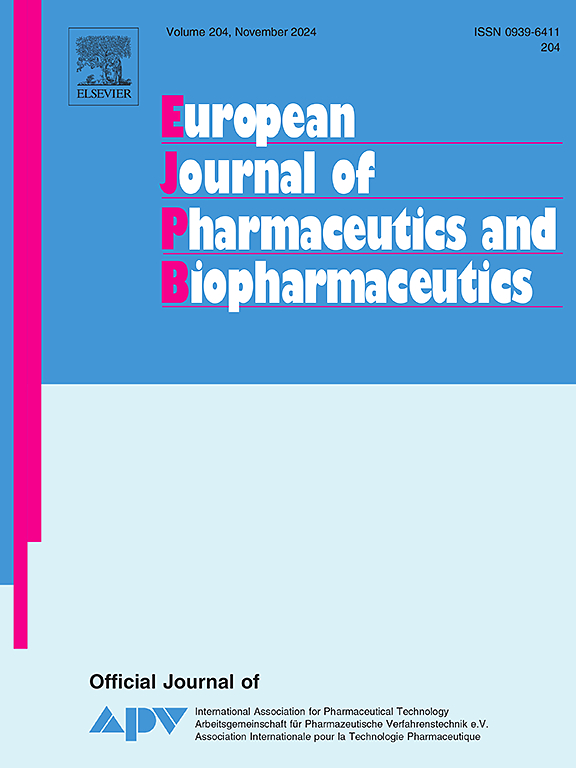Metallomic evaluation of selenium nanoparticles and selenomethionine for the attenuation of cisplatin-induced nephrotoxicity
IF 4.4
2区 医学
Q1 PHARMACOLOGY & PHARMACY
European Journal of Pharmaceutics and Biopharmaceutics
Pub Date : 2025-05-08
DOI:10.1016/j.ejpb.2025.114737
引用次数: 0
Abstract
Nephrotoxicity is one of the most limiting side effects in oncologic patients treated with cisplatin and is still clinically unresolved. In this work, chitosan-stabilised selenium nanoparticles (Ch-SeNPs) and selenomethionine (SeMet) have been evaluated as nephroprotectors of cisplatin using renal proximal tubule epithelial cells (RPTEC/TERT1) as a model. Moreover, the antineoplastic efficacy of cisplatin co-administered with these selenocompounds has been tested in cervical cancer cells (HeLa). Cell viability, cell localisation of Ch-SeNPs and changes in the morphology and cell ultrastructure, Pt and Se cellular internalisation and cisplatin binding to DNA, and speciation of Pt and Se in the cytosolic extracts were evaluated by MTT assays, transmission electron microscopy coupled to energy dispersive X-ray spectroscopy (TEM-EDS), inductively coupled plasma mass spectrometry (ICP-MS), and both size exclusion chromatography (SEC) and anion exchange chromatography (AEC) coupled to either ICP-MS or UV–Vis. Differences in the pharmacological activity of the two selenospecies were observed. SeMet exerted a moderate protection on kidney cells while reducing their degree of cisplatin intracellular accumulation and DNA binding in both cell lines, but the antitumour effect of cisplatin was not significantly altered. Conversely, Ch-SeNPs did not impair the Pt-drug uptake or DNA binding in any cell type; and even increased its antitumour effect, which might enable using lower doses of cisplatin without loss of anticancer efficacy, which would result in decreased risk of renotoxicity. Furthermore, cells incubated either with SeMet or SeNPs showed higher levels of selenoproteins, which might enhance cellular defences against the reactive oxygen species (ROS) involved in cisplatin renotoxicity. Hence, both selenocompounds are envisioned as potential coadjuvants to reduce the risk of kidney impairment in future treatments with cisplatin.

纳米硒和硒代蛋氨酸对顺铂肾毒性衰减的金属学评价
肾毒性是肿瘤患者顺铂治疗中最有限的副作用之一,临床上仍未解决。在这项工作中,壳聚糖稳定的硒纳米颗粒(Ch-SeNPs)和硒代蛋氨酸(SeMet)以肾近端小管上皮细胞(RPTEC/TERT1)为模型,被评估为顺铂的肾保护剂。此外,顺铂与这些硒化合物共同施用的抗肿瘤效果已在宫颈癌细胞(HeLa)中进行了测试。采用MTT法、透射电子显微镜结合能量色散x射线能谱法(TEM-EDS)、电感耦合等离子体质谱法(ICP-MS)评估细胞活力、Ch-SeNPs的细胞定位、形态和细胞超微结构的变化、铂和硒的细胞内化和顺铂与DNA的结合以及细胞质提取物中铂和硒的形态。尺寸排除色谱(SEC)和阴离子交换色谱(AEC)与ICP-MS或UV-Vis偶联。观察了两种硒的药理活性差异。SeMet对肾细胞有一定的保护作用,同时降低了顺铂在两种细胞系的细胞内积聚程度和DNA结合程度,但顺铂的抗肿瘤作用没有明显改变。相反,Ch-SeNPs在任何细胞类型中都不会损害pt -药物摄取或DNA结合;甚至增加了它的抗肿瘤作用,这可能使使用更低剂量的顺铂而不失去抗癌功效,从而降低肾毒性的风险。此外,用SeMet或SeNPs培养的细胞显示出更高水平的硒蛋白,这可能增强细胞对参与顺铂肾毒性的活性氧(ROS)的防御。因此,这两种硒化合物被设想为潜在的辅助剂,以降低未来顺铂治疗中肾脏损害的风险。
本文章由计算机程序翻译,如有差异,请以英文原文为准。
求助全文
约1分钟内获得全文
求助全文
来源期刊
CiteScore
8.80
自引率
4.10%
发文量
211
审稿时长
36 days
期刊介绍:
The European Journal of Pharmaceutics and Biopharmaceutics provides a medium for the publication of novel, innovative and hypothesis-driven research from the areas of Pharmaceutics and Biopharmaceutics.
Topics covered include for example:
Design and development of drug delivery systems for pharmaceuticals and biopharmaceuticals (small molecules, proteins, nucleic acids)
Aspects of manufacturing process design
Biomedical aspects of drug product design
Strategies and formulations for controlled drug transport across biological barriers
Physicochemical aspects of drug product development
Novel excipients for drug product design
Drug delivery and controlled release systems for systemic and local applications
Nanomaterials for therapeutic and diagnostic purposes
Advanced therapy medicinal products
Medical devices supporting a distinct pharmacological effect.

 求助内容:
求助内容: 应助结果提醒方式:
应助结果提醒方式:


